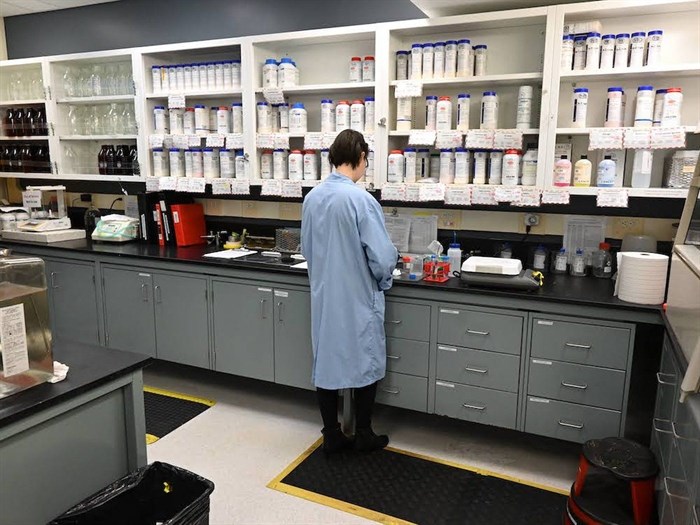
Bacteria, viruses, moulds and fungi love our food and food systems and can thrive if given the opportunity.
Image Credit: Michelle Gamage, Local Journalism Initiative
November 11, 2024 - 7:00 PM
The petri dish shimmers with colour, flashing a rich, emerald-green iridescence under the fluorescent lights of the laboratory.
The lab technician leans in with a wide grin. “That’s E. coli,” she explains.
E. coli is just one of the beautiful, brightly coloured samples of bacteria flourishing in similarly flashy petri dishes, which are filled with a nutritional goop, known as an agar medium, that is designed to make the bacteria react in a specific way, such as turning a specific colour.
There’s the iridescent green E. coli against a root beer-coloured agar, black Staphylococcus aureus against a milky lemon-coloured medium, dove-grey Listeria monocytogenes against a salmon-coloured medium, and translucent salmonella against a cream soda pink-coloured medium.
The fantastical colours make it hard to stomach that these are all bustling colonies of bacteria that could cause severe food poisoning if eaten.
Luckily, it’s safe to lean in and take a look — just as long as you don’t touch.
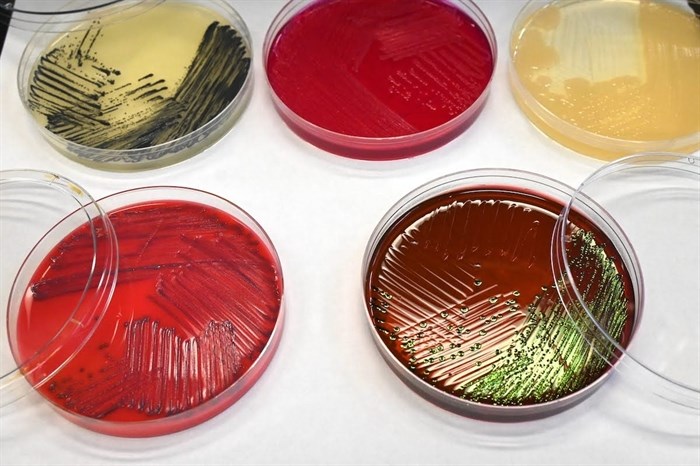
Bacteria samples, such as E. coli, listeria and salmonella, shimmering in agar media. You can look — but don’t touch!
Image Credit: Michelle Gamage, Local Journalism Initiative
Adding to the sense of security is the watchful eye of Carolyn Bateman, director of the Canadian Food Inspection Agency lab.
Bateman first spoke with The Tyee in late August for an article about CFIA’s work testing for deadly shellfish toxins.
As she answered increasingly detailed questions over the phone for that article, including questions about the lab, she suggested The Tyee come down to see it in person.
How CFIA helps keep Canadians safe
You’ve likely heard of the Canadian Food Inspection Agency before. It’s the organization that sends out food recall notices if there’s a string of related cases of food poisoning, or if a product is found to be unsafe.
Food production is heavily regulated, and there are extensive protocols and safety measures in place to make sure food is safely harvested, shipped, stored, prepared and cooked.
But the problem with food is that humans aren’t the only creatures that think it’s great. Bacteria, viruses, moulds and fungi also love our food and food systems and can thrive if given the opportunity, which can then give humans food poisoning when we chow down unsuspectingly.
Small mistakes, accidents or oversights can lead to big consequences — for example, the 2023 E. coli outbreak in 17 Calgary daycares that led to 448 infections and 39 hospitalizations, all of which stemmed from meat loaf containing E. coli.

Meat samples are being tested for sulphites. Added sulphites at levels of 10 parts per million or more must be clearly identified on food labels.
Image Credit: Michelle Gamage, Local Journalism Initiative
The Canadian Food Inspection Agency works to catch those mistakes and intervene as quickly as possible. Food safety inspectors support investigations or respond to public health requests for testing if somebody gets sick or has an allergic reaction. This testing is considered “on demand.”
There’s also “targeted” or “directed” testing, which keeps an eye on a commodity for a set time. This could be because a problem happened locally or elsewhere in the world, Bateman says.
Finally, there’s “routine monitoring and surveillance” for shellfish biotoxin testing or when the industry is new and CFIA wants to understand its product compliance.
CFIA also tests food for biotoxins, pathogens that could cause food poisoning and allergen contamination in foods marketed as allergen-free, and if products really are as advertised (for example, if a product is really vegan, 100 per cent honey, if the expensive cut of fish is actually from the species it’s sold as, and that there aren’t harmless but unpleasant bugs in food).
The only biotoxin lab in Western Canada
Shellfish testing makes up about three-fifths of the work done at the lab, Bateman says. Shellfish from along the entire Canadian portion of the Pacific coast are shipped to the Burnaby lab to be tested for biotoxins. If they test negative, an area is considered “open” and safe to harvest seafood from.

More than 100 bivalve samples arrive at the CFIA lab weekly, needing to be tested for toxins that cause paralytic shellfish poisoning, amnesic shellfish poisoning and diarrhetic shellfish poisoning.
Image Credit: Michelle Gamage, Local Journalism Initiative
The BC Centre for Disease Control and Fisheries and Oceans Canada both have maps that show what areas are open for harvest. The Can U Dig It app is a free, mobile-friendly version of the DFO map.
It’s a credit to the work of this lab that shellfish-related biotoxin poisonings are rare in B.C., despite the enormous amount of year-round, fresh seafood we eat and export and the high instance of biotoxin blooms in B.C. waters. Even late in the season, nearly the entire BCCDC map of the coast is stained yellow, indicating coastal areas are closed due to biotoxins.
The Burnaby CFIA lab is the only biotoxin lab in Western Canada.
“It’s expensive and infrastructure-heavy, and the price that a private lab might have to charge for that service could be cost-prohibitive to industry,” Bateman says.
She adds that government has been putting a lot of research and energy into seeking out safe, alternative forms of testing that could be cheaper and hopefully more accessible.
During the warm months, more than 100 bivalve samples arrive weekly, needing to be tested for toxins that cause paralytic shellfish poisoning, amnesic shellfish poisoning and diarrhetic shellfish poisoning. The first two might kill you; the latter likely won’t, but it will cause a severe case of food poisoning.
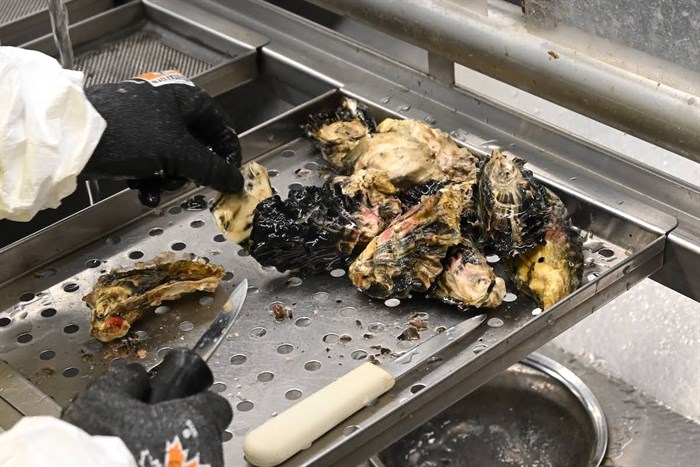
Oysters are being prepared for testing at the CFIA lab.
Image Credit: Michelle Gamage, Local Journalism Intiative
These toxins occur naturally in the ocean and slowly build up in filter-feeder shellfish such as mussels, clams, scallops and oysters. All three toxins are odourless, tasteless and colourless and can’t be cooked off.
Other naturally occurring marine pathogens, such as vibrio bacteria, can be easily cooked off, so if oysters were contaminated with vibrio they could be cooked or smoked and then safely eaten.
How testing works
Samples arrive in a small receiving area and can be fresh, frozen or canned, depending on what they’re being tested for. Staff wear yellow aprons and rubber gloves as they shuck and defrost shellfish.
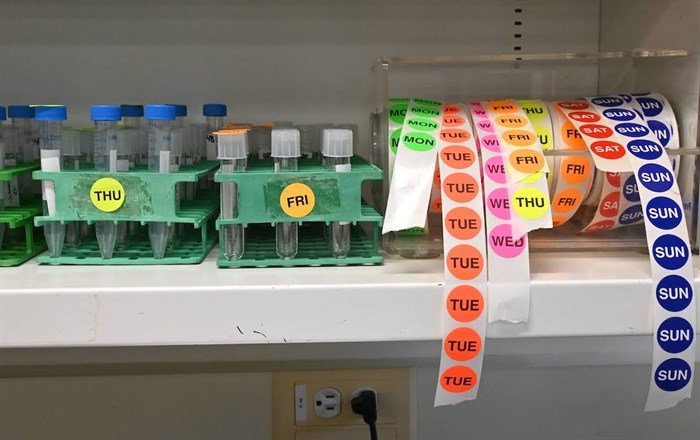
The CFIA lab can do 60 different testing methods, each of which can be used to test around 10 different types of food.
Image Credit: Michelle Gamage, Local Journalism Initiative
Bateman, pointing out several areas marked with biohazard or poison warnings, says everyone at the lab is certified to handle these hazardous materials and the lab is licensed to handle toxins and pathogens.
After the oysters are shucked, they’re ground in a sterile blender, which evenly spreads any possible toxins all throughout the sample, reducing the risk of a false negative.
In the beating, clicking heart of the seafood testing industry, CFIA analyzes prepared shellfish samples using high-pressure liquid chromatography.
These machines explain their findings using graphs, with peaks appearing at different times showing the presence of different molecules. Staff compare these graphs with graphs produced by a known biotoxin sample. Sample peaks appearing at the same time as the known toxin confirm presence in the sample.
There are 12 toxins that make up paralytic shellfish poisoning. All toxins are tested for and then added together to see if it creates a risk of PSP, Bateman says.
In the cleaning room, hundreds of stainless steel blenders and glass test tubes are cleaned in large dishwashers. Sterilization is important, Bateman says — you want to be sure anything you find is from that sample, not a contaminated blender.
The lab has “a really large scope” and can do 60 different testing methods, which can each be used to test around 10 different types of food, Bateman says. Because so much of the testing is done on demand, the lab has thousands of bottles of media preparation that can be mixed to test samples.
The media preparation room looks like a mash-up of an industrial kitchen and a pharmacy; smell-wise, it has the underlying funk of wet wool carpet. It’s the only room that has a hint of unpleasant odour — the room where shellfish are shucked smells faintly of salt, but mostly of water and dish detergent.
Every room in the lab is climate controlled to a specific temperature and humidity, which helps control what microbes can grow, Bateman says.
Everything in the lab is also tightly controlled. The water that comes out of the taps in the building has been “polished,” meaning it is put through a reverse-osmosis filter to remove minerals that could throw off delicate experiments. The air and water are cleaned again before they are released from the lab too, she says.
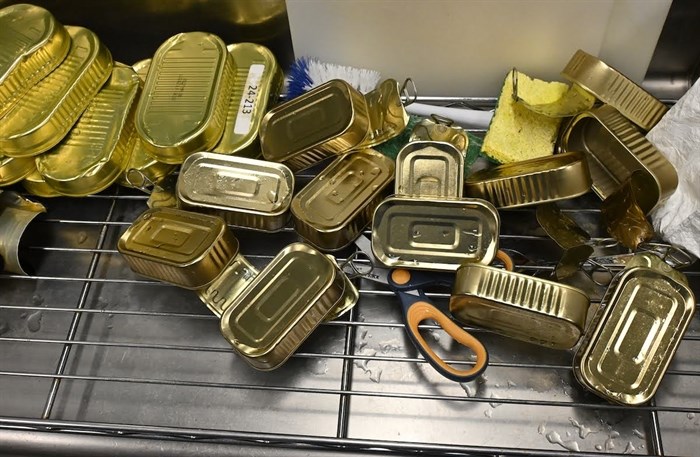
The CFIA lab does regular screening and monitoring of seafood, including canned seafood, for biotoxins or other toxins that could cause food poisoning.
Image Credit: Michelle Gamage, Local Journalism Initiative
Staff and visitors follow safety protocols to prevent moving microscopic bugs around as they go from room to room. Each area is colour-coded to explain what safety protocols are required and what materials can or cannot enter or exit the room.
The area that tests for viruses, for example, is off limits for The Tyee’s visit — the room needs additional personal protective equipment that requires training to put on and remove. The main virus CFIA tests for, Bateman says, is norovirus, a leading cause of food poisoning. Norovirus is usually behind outbreaks on cruise ships.
‘Mycotoxins were responsible for people being hung or burned at the stake’
CFIA also tests for mycotoxins, which are produced by moulds and fungi. These grow on late-season fruit like apples and can end up in fruit juices.
Mycotoxins have a curious relationship to the European witch trials that happened in the 1500s. At the time, witchcraft was blamed for creepy events, such as an incident where people danced uncontrollably in the streets for days. Instead of witchcraft, the more likely culprit was the contamination of a rye crop with the mycotoxin ergot, which causes severe hallucinations and convulsions when eaten, Bateman says.
“Mycotoxins were responsible for people being hung or burned at the stake,” Bateman says. “They’re a very important toxin.”
Upstairs at CFIA are labs to test foods like hamburger and shrimp for sulphites. In one room, a staffer is checking the accuracy of a simplified gluten contagion test.
Lest you think it’s always serious work at the lab, Bateman says sometimes staff are sent out shopping for doughnuts.
Sadly, not for workplace snacks. But happily, for Canadians, as the doughnuts are fed into machines so staff know what to expect from a normal graph readout for a doughnut and can compare it with a potentially contaminated sample, meaning you can confidently walk into your neighbourhood doughnut shop and order a Boston cream without worrying that it might keep you stuck in the bathroom for days.
— This story was originally published by The Tyee
News from © iNFOnews, 2024